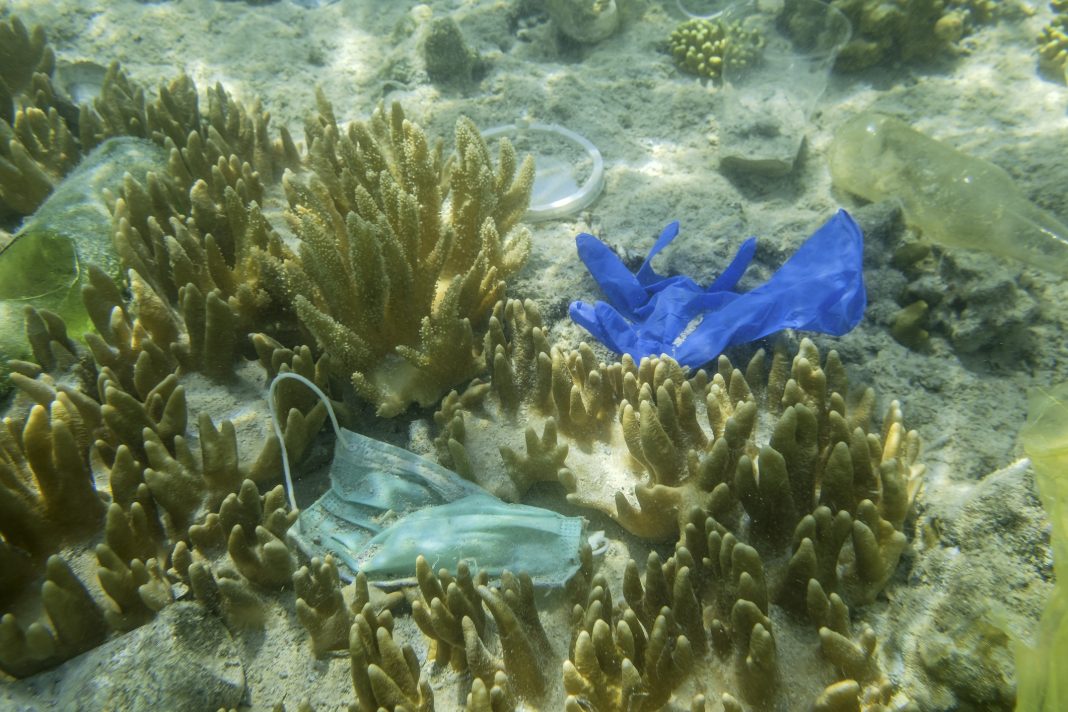The pandemic has increased demand for single-use plastics such as face masks, gloves, and face shields – so what happens to COVID-related plastic waste?
The subsequent waste has intensified pressure on the existing severe worldwide plastic pollution problem.
A new study led by a team of researchers at Nanjing University’s School of Atmospheric Sciences and UC San Diego’s Scripps Institution of Oceanography, is first to project the enormity and outcome of the waste in the oceans.
“A virtual reality” of how sea water works
The study used a newly developed ocean plastic numerical model, The Nanjing University MITgcm-plastic model (NJU-MP), to measure the impact of the pandemic on plastic discharge from land sources. It found that most of the global plastic waste entering the ocean is coming from Asia, with hospital waste representing the bulk of the land discharge.
“The model simulates how the seawater moves driven by wind and how the plastics float on the surface ocean, degraded by sunlight, fouled by plankton, landed on beaches, and sunk to the deep,” said co-author Yanxu Zhang. “It can be used to answer ‘what if’ questions, for example, what will happen if we add a certain amount of plastics to the ocean?”
The model is built based on Newton’s laws of motion and the law of conservation of mass. From it, researchers found that more than eight million tons of pandemic-associated plastic waste have been produced globally, with over 25,000 tons entering the ocean since the start of the pandemic in 2020 through August 2021.
“There is a pretty consistent circulation pattern in the ocean, and that’s why we can build models that replicate how the ocean moves—it’s just physical oceanography at this point,” said study co-author Amina Schartup, an assistant professor at Scripps Oceanography.
“We know that if waste is released from Asian rivers into the North Pacific Ocean, some of that debris will likely end up in the Arctic Ocean—a kind of a circular ocean which can be a bit like an estuary, accumulating all kinds of things that get released from the continents.”
Graduate students Yiming Peng and Peipei Wu of Nanjing University led the research, which was published Nov. 8 in the journal Proceedings of the National Academy of Sciences.
“Better management of medical waste in developing countries is needed”
Unfortunately, a large portion of this ocean plastic debris is expected to travel to beaches or the seabed, as well as open ocean or subtropical gyres, garbage patches and the circumpolar plastic accumulation zone in the Arctic Ocean within the next four years.
Asian rivers account for 73 of the total discharge of plastics, with the top three contributors being the Shatt al-Arab, Indus, and Yangtze rivers, which discharge into the Persian Gulf, Arabian Sea, and East China Sea. European rivers accounted for 11% of the discharge, with other minor inputs from other continents also.
The study further focusses on particular rivers and watersheds which have formerly required additional attention in plastic waste management. It revealed that most global plastic waste from the pandemic is entering the ocean from rivers, likely ending up circulating in the Arctic Ocean, becoming a “dead-end” for plastic debris, due to ocean circulation patterns.
Schartup added: “When we started doing the math, we were surprised to find that the amount of medical waste was substantially larger than the amount of waste from individuals, and a lot of it was coming from Asian countries, even though that’s not where most of the COVID-19 cases were,”
“The biggest sources of excess waste were hospitals in areas already struggling with waste management before the pandemic; they just weren’t set up to handle a situation where you have more waste.”
The model shows that about 80% of the plastic debris that transits into the Arctic Ocean will sink quickly, and a circumpolar plastic accumulation zone is modelled to form by 2025.
With the Arctic ecosystem being already vulnerable due to the harsh environment and high sensitivity to climate change, the potential ecological impacts of COVID-19 plastics adds more pressure to prevent the problem.
The authors of the study call for better management of medical waste in epicenters, especially in developing countries of which the most plastic is being developed.
Additionally, they advocate for global public awareness of the environmental impact of personal protection equipment (PPE) and other plastic products, stating the need to develop more sustainable technologies for better plastic waste collection, classification, treatment, and recycling.
“Indeed, the COVID-related plastic is only a portion of a bigger problem we face in the 21st century: plastic waste,” said Zhang. “To solve it requires a lot of technical renovation, transition of economy, and change of lifestyle.”











